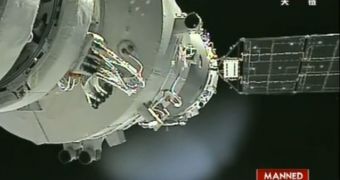Officials with the Chinese National Space Administration (CNSA) announce the successful completion of its first manned orbital docking maneuver ever. The success comes less than a year after the first successful unmanned docking.
The latter occurred between the robotic Tiangong-1 and Shenzhou 8 spacecraft, at 1730 GMT on November 2, 2011. The vehicles docked and undocked from each other several times over, in order to ensure that the procedure can be repeated.
According to CNSA, robotic docking procedures are more complex than manned ones, and this is why the agency began with the former. After ensuring that it can hook up two robotic space modules to each other, it proceeded to launch a manned vehicle as well.
The Shenzhou 9 capsule that carried three Chinese astronauts to space took off on June 16 from the Jiuquan Satellite Launch Center, aboard a Long March 2F delivery system. The trio successfully docked the vehicle to the Tiangong-1 module on June 18.
Shenzhou 9 is manned by astronauts Liu Wang and Jing Haipeng, who are joined by Liu Yang, the first CNSA female astronaut to make her way to space.
Yesterday, June 24, the crew conducted the same maneuver again, as the spacecraft were flying about 213 miles (343 kilometers) above the planet. The second docking was carried out manually, demonstrating that CNSA can now count on this capability as well, Space reports.
China has very ambitious plans for the future. According to medium-term plans unveiled by the CNSA, the Asian nation means to make a space lab operational by 2020.
Though it will most likely be considerably smaller than the International Space Station, assembling such a structure would demonstrate China's commitment to space exploration yet again. It took international partners more than a decade and $100 billion to construct the ISS.
“The success of the manual rendezvous and docking mission represents another important phase achievement of the Shenzhou 9 and Tiangong 1 rendezvous and docking mission,” says Wu Ping.
“The three astronauts will once again enter the orbiting module of Tiangong 1 to carry out scientific experiments,” adds the official, who is the spokeswoman of the China Manned Space Program.
The Shenzhou 9 spacecraft – which is modeled after the Russian Soyuz capsule – will remain docked to the Tiangong-1 module until June 28. The mission will conclude when the vehicle parachutes back to Earth, on June 29.

 14 DAY TRIAL //
14 DAY TRIAL //